《管理学》课程PPT教学课件(Management, 7th Edition)Chapter 18 FOUNDATIONS OF CONTROL
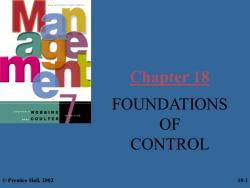
Chapter 18 FOUNDATIONS DROB BI NS ACOULTER OF CONTROL ©Prentice Hall,2002 18-1
Chapter 18 FOUNDATIONS OF CONTROL © Prentice Hall, 2002 18-1
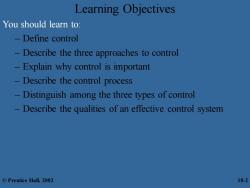
Learning Objectives You should learn to: Define control Describe the three approaches to control Explain why control is important Describe the control process Distinguish among the three types of control -Describe the qualities of an effective control system ©Prentice Hall,2002 18-2
Learning Objectives You should learn to: – Define control – Describe the three approaches to control – Explain why control is important – Describe the control process – Distinguish among the three types of control – Describe the qualities of an effective control system © Prentice Hall, 2002 18-2
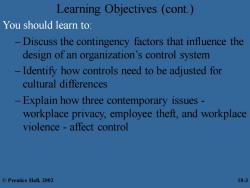
Learning Objectives (cont. You should learn to: Discuss the contingency factors that influence the design of an organization's control system Identify how controls need to be adjusted for cultural differences Explain how three contemporary issues workplace privacy,employee theft,and workplace violence affect control ©Prentice Hall,2002 18-3
Learning Objectives (cont.) You should learn to: – Discuss the contingency factors that influence the design of an organization’s control system – Identify how controls need to be adjusted for cultural differences – Explain how three contemporary issues - workplace privacy, employee theft, and workplace violence - affect control © Prentice Hall, 2002 18-3
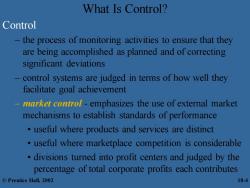
What Is Control? Control -the process of monitoring activities to ensure that they are being accomplished as planned and of correcting significant deviations control systems are judged in terms of how well they facilitate goal achievement marker control-emphasizes the use of external market mechanisms to establish standards of performance useful where products and services are distinct useful where marketplace competition is considerable divisions turned into profit centers and judged by the percentage of total corporate profits each contributes ©Prentice Hall,2002 18-4
What Is Control? Control – the process of monitoring activities to ensure that they are being accomplished as planned and of correcting significant deviations – control systems are judged in terms of how well they facilitate goal achievement – market control - emphasizes the use of external market mechanisms to establish standards of performance • useful where products and services are distinct • useful where marketplace competition is considerable • divisions turned into profit centers and judged by the percentage of total corporate profits each contributes © Prentice Hall, 2002 18-4

What Is Control?(cont. Control bureauerutic control emphasizes organizational authority relies on administrative rules,procedures,and policies depends on standardization of activities,well-defined job descriptions,and other administrative mechanisms -clan controll-behavior regulated by shared values, traditions,and other aspects of organizational culture dependent on individual and group to identify expected behaviors and performance measures found where teams are common and technology changes often ©Prentice Hall,2002 18-5
What Is Control? (cont.) Control – bureaucratic control - emphasizes organizational authority • relies on administrative rules, procedures, and policies • depends on standardization of activities, well-defined job descriptions, and other administrative mechanisms – clan control - behavior regulated by shared values, traditions, and other aspects of organizational culture • dependent on individual and group to identify expected behaviors and performance measures • found where teams are common and technology changes often © Prentice Hall, 2002 18-5
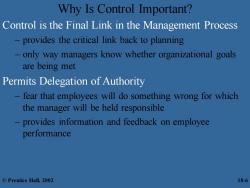
Why Is Control Important? Control is the Final Link in the Management Process provides the critical link back to planning only way managers know whether organizational goals are being met Permits Delegation of Authority fear that employees will do something wrong for which the manager will be held responsible provides information and feedback on employee performance ©Prentice Hall,2002 18-6
Why Is Control Important? Control is the Final Link in the Management Process – provides the critical link back to planning – only way managers know whether organizational goals are being met Permits Delegation of Authority – fear that employees will do something wrong for which the manager will be held responsible – provides information and feedback on employee performance © Prentice Hall, 2002 18-6
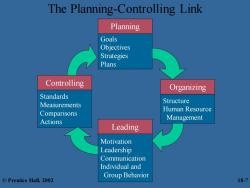
The Planning-Controlling Link Planning Goals Objectives Strategies Plans Controlling Organizing Standards Structure Measurements Human Resource Comparisons Management Actions Leading Motivation Leadership Communication Individual and Group Behavior ©Prentice Hall,2002 18-7
Structure Human Resource Management Organizing The Planning-Controlling Link Standards Measurements Comparisons Actions Controlling Goals Objectives Strategies Plans Planning Motivation Leadership Communication Individual and Group Behavior Leading © Prentice Hall, 2002 18-7
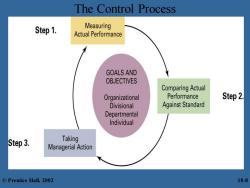
The Control Process Step 1. Measuring Actual Performance GOALS AND OBJECTIVES Comparing Actual Organizational Performance Step 2. Divisional Against Standard Departmental Individual Step 3. Taking Managerial Action ©Prentice Hall,2002 18-8
The Control Process © Prentice Hall, 2002 18-8
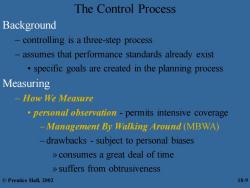
The Control Process Background controlling is a three-step process assumes that performance standards already exist specific goals are created in the planning process Measuring How We Measure personal observation permits intensive coverage -Management By Walking Around (MBWA) drawbacks -subject to personal biases >consumes a great deal of time >suffers from obtrusiveness ©Prentice Hall,2002 18-9
The Control Process Background – controlling is a three-step process – assumes that performance standards already exist • specific goals are created in the planning process Measuring – How We Measure • personal observation - permits intensive coverage –Management By Walking Around (MBWA) – drawbacks - subject to personal biases »consumes a great deal of time »suffers from obtrusiveness © Prentice Hall, 2002 18-9

The Control Process(cont. Measuring (cont.) -How We Measure (cont.) statisticall reporis-numerical data are easy to visualize and effective for showing relationships -drawbacks-not all operations can be measured >important subjective factors may be ignored orall reporis-includes meetings,telephone calls -may be best way to control work in a virtual environment - technology permits creation of written record from oral report drawbacks-filtering of information ©Prentice Hall,2002 18-10
The Control Process (cont.) Measuring (cont.) – How We Measure (cont.) • statistical reports - numerical data are easy to visualize and effective for showing relationships – drawbacks - not all operations can be measured »important subjective factors may be ignored • oral reports - includes meetings, telephone calls –may be best way to control work in a virtual environment – technology permits creation of written record from oral report – drawbacks - filtering of information © Prentice Hall, 2002 18-10
按次数下载不扣除下载券;
注册用户24小时内重复下载只扣除一次;
顺序:VIP每日次数-->可用次数-->下载券;
- 《管理学》课程PPT教学课件(Management, 7th Edition)Chapter 16 MOTIVATING EMPLOYEES.ppt
- 《管理学》课程PPT教学课件(Management, 7th Edition)Chapter 15 UNDERSTANDING GROUPS AND TEAMS.ppt
- 《管理学》课程PPT教学课件(Management, 7th Edition)Chapter 14 FOUNDATIONS OF BEHAVIOR.ppt
- 《管理学》课程PPT教学课件(Management, 7th Edition)Chapter 13 MANAGING CHANGE AND INNOVATION.ppt
- 《管理学》课程PPT教学课件(Management, 7th Edition)Chapter 12 HUMAN RESOURCE MANAGEMENT(HRM).ppt
- 《管理学》课程PPT教学课件(Management, 7th Edition)Chapter 11 MANAGERIAL COMMUNICATION AND INFORMATION TECHNOLOGY.ppt
- 《管理学》课程PPT教学课件(Management, 7th Edition)Chapter 10 ORGANIZATIONAL STRUCTURE AND DESIGN.ppt
- 《管理学》课程PPT教学课件(Management, 7th Edition)Chapter 09 PLANNING TOOLS AND TECHNIQUES.ppt
- 《管理学》课程PPT教学课件(Management, 7th Edition)Chapter 08 STRATEGIC MANAGEMENT.ppt
- 《管理学》课程PPT教学课件(Management, 7th Edition)Chapter 07 FOUNDATIONS OF PLANNING.ppt
- 《管理学》课程PPT教学课件(Management, 7th Edition)Chapter 06 DECISION MAKING:THE ESSENCE OF THE MANAGER’S JOB.ppt
- 《管理学》课程教学资源(课件讲义)Stephen P.Robbins(9)Chapter 2 Management Yesterday and Today.pdf
- 《管理学》课程教学资源(课件讲义)Stephen P.Robbins(9)Chapter 1 Introduction to Management and Organizations.pdf
- 《管理学》课程教学资源(教师手册)Stephen P.Robbins(9)CHAPTER TWO Management Yesterday.pdf
- 《管理学》课程教学资源(教师手册)Stephen P.Robbins(9)CHAPTER ONE Introduction to Management.pdf
- 《管理学》课程PPT教学课件(Management)Stephen P.Robbins(9)第十二章 人力资源管理 Human Resource Management.ppt
- 《管理学》课程PPT教学课件(Management)Stephen P.Robbins(9)第十章 组织结构与设计 Organizational Structure and Design.ppt
- 《管理学》课程PPT教学课件(Management)Stephen P.Robbins(9)第十五章 理解群体与团队 Understanding Groups and Teams.ppt
- 《管理学》课程PPT教学课件(Management)Stephen P.Robbins(9)第十九章 运营及价值链管理 Operations and Value Chain Management.ppt
- 《管理学》课程PPT教学课件(Management)Stephen P.Robbins(9)第三章 组织文化与环境——约束力量 Organizational Culture and Environment - The Constraints.ppt
- 《管理学》课程PPT教学课件(Management, 7th Edition)Chapter 19 OPERATIONS AND VALUE CHAIN MANAGEMENT.ppt
- 《管理学》课程PPT教学课件(Management, 7th Edition)Chapter 20 CONTROLLING FOR ORGANIZATIONAL PERFORMANCE.ppt
- 《管理学》课程教学资源(实验讲义)企业竞争模拟攻略篇.pdf
- 《管理学》课程教学资源(习题与答案)第1章 管理活动与管理理论.doc
- 《管理学》课程教学资源(习题与答案)第3章 全球化与管理.doc
- 《管理学》课程教学资源(习题与答案)第6章 计划与计划工作.doc
- 《管理学》课程教学资源(习题与答案)第十章 组织变革与组织文化.doc
- 《管理学》课程教学资源(习题与答案)第16章 管理的创新职能.doc
- 《管理学》课程教学资源(习题与答案)第1章 管理活动与管理理论.doc
- 《管理学》课程教学资源(习题与答案)第3章 全球化与管理.doc
- 《管理学》课程教学资源(习题与答案)第4章 信息与信息化管理.doc
- 《管理学》课程教学资源(习题与答案)第5章 决策与决策方法.doc
- 《管理学》课程教学资源(习题与答案)第6章 计划与计划工作.doc
- 《管理学》课程教学资源(习题与答案)第7章 战略性计划与战略实施.doc
- 《管理学》课程教学资源(习题与答案)第8章 组织设计.doc
- 《管理学》课程教学资源(习题与答案)第9章 人力资源管理.doc
- 《管理学》课程教学资源(习题与答案)第10章 组织变革与组织文化.doc
- 《管理学》课程教学资源(习题与答案)第11章 领导概论.doc
- 《管理学》课程教学资源(习题与答案)第12章 激励.doc
- 《管理学》课程教学资源(习题与答案)第13章 沟通.doc
